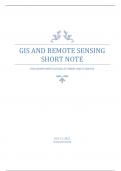GIS AND REMOTE SENSING
SHORT NOTE
FOR HIGHER INSTITUATION LECTURERS AND STUDENTS
JULY 11, 2021
ADIMAS BASHAGER
,1. Discuss and explain the following terms: GIS, RS AND GPS
1. BASIC CONCEPT OF GIS Google Earth User Guide
What does GIS stand for?
✓ Geographic Information Science is the science concerned with the systematic and
automatic processing of spatial data and information with the help of computers
✓ Geographic Information System is a system designed for storing, analyzing, and
displaying spatial data.
✓ it is the use of hardware, software, people, procedures, and data.
Literal Definition: GIS is a system which is build up on three basic terms
Geographic- relates to the surface of the earth. geography is an organized body of knowledge
about the distribution and organization of phenomena on the surface of the earth and the factors
that govern this distribution.”
❖ Information is a knowledge derived from study, experience, or instruction.
❖ System is a group of interacting, interrelated, or interdependent elements forming a
complex whole.
❖ Science is the observation, identification, description, experimental investigation, and
theoretical explanation of phenomena.
❖ 1.2. Why GIS?
❖ Geographic: means real world or spatial realities. Geographic, because data collected is
associated with some location in space.
❖ Information: means data and their meanings. It is so-called information, because attributes or
the characteristic (data), about the space is what we want to learn about.
❖ System: It based on computer technology. It is a System, because there must be a tie from the
information to the geography in a seamless operation.
GIS combines three aspects: Geography + Information + System.
❖ Geography is related to features and processes that occur on the surface of the earth.
❖ Information is the heart of GIS, whereby vast amounts of data are stored and analyzed.
1 Set by Adimasu.T
, ❖ System is what connects everything – the hardware, software, data, and human operator – all
working together to ask questions, discover answers, and display them in ways that promote
understanding of what it means to live on earth
2. Functional Definition
GIS is a system for capturing, storing, checking, inputting, integrating, manipulating,
analyzing, displaying and reporting the data which are spatially referenced data.
➢ A Geographic Information System (GIS) is a computer system for capturing, storing,
querying, analyzing, and displaying geographic data that has been transmitted from
navigation systems such as GPS.
➢ it is a computer-based system that provides four sets of capabilities to handle geo
referenced data (4 fundamental elements of GIS)
1. data input- provides operational functions for acquiring data: such as, surveying, RS,
digitizing, photogrammetry.
2. data management (storage and retrieval). Store and retrieves the data elements.
3. data manipulation and analyze. Handles the transformation of data from one form to
another.
4. data Output/ reporting- printing, plotting or cartographic. To see data in the form of
diagrams, maps and tables
2 Set by Adimasu.T
, “A system for capturing, storing, checking, integrating, manipulating, analyzing and
displaying data which are spatially referenced to the Earth. This is normally considered
to involve a spatially referenced computer database and appropriate applications
software”. Chorley Report, 1987
FUNCTIONAL COMPONENTS OF GIS
❖ Data input: bring data in to GIS environment
❖ Data management: controlling access to the data
❖ Data manipulation: allowing alteration of primary data/transformation from
1 to another
❖ Data storage: maintaining data in GIS format
❖ Data output: moving data out of GIS
❖ Data retrieval: calling data from a stored format in to use
❖ Data display: visualizing primary or derived data
❖ Data collection, Capture data, Data storing, processing & analysis, Store
data, Query data, analyze data, Output production, Display data, Produce
output.
Discuss briefly the GIS functions
· Data acquisition (spatial and non-spatial)
· Data processing (data management)
· Data analysis (Spatial & statistical analysis)
· Data storage (Store data more efficiently)
· Data output (Maps, graphs, tables, reports)
➢ “An information technology which stores, analyses and display both spatial and
non–spatial data”.
➢ GIS is a system of computer software, hardware, data, procedures and personnel
combined to help, manipulate, analyse, and present information that is tied to a
geographic location. (functional vs componential definition )
Basic Terms in GIS
➢ Point: a single location having an X, Y (and sometimes, a Z) position (point features
have no area and no length). Houses, address, traffic accidents, water tower stations, tows
3 Set by Adimasu.T




